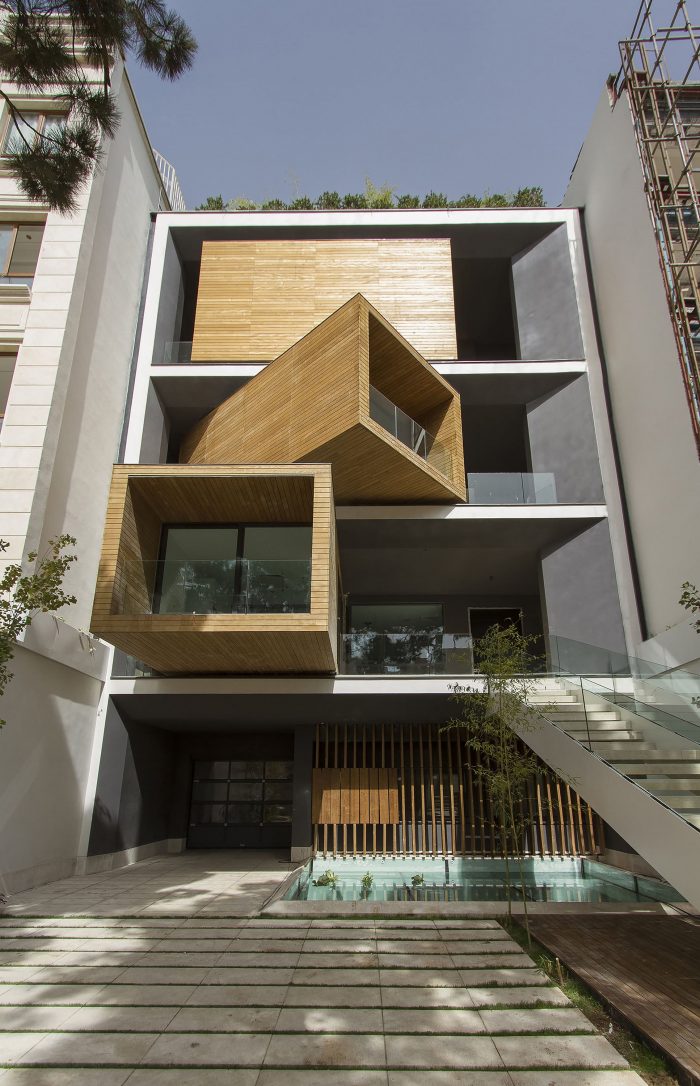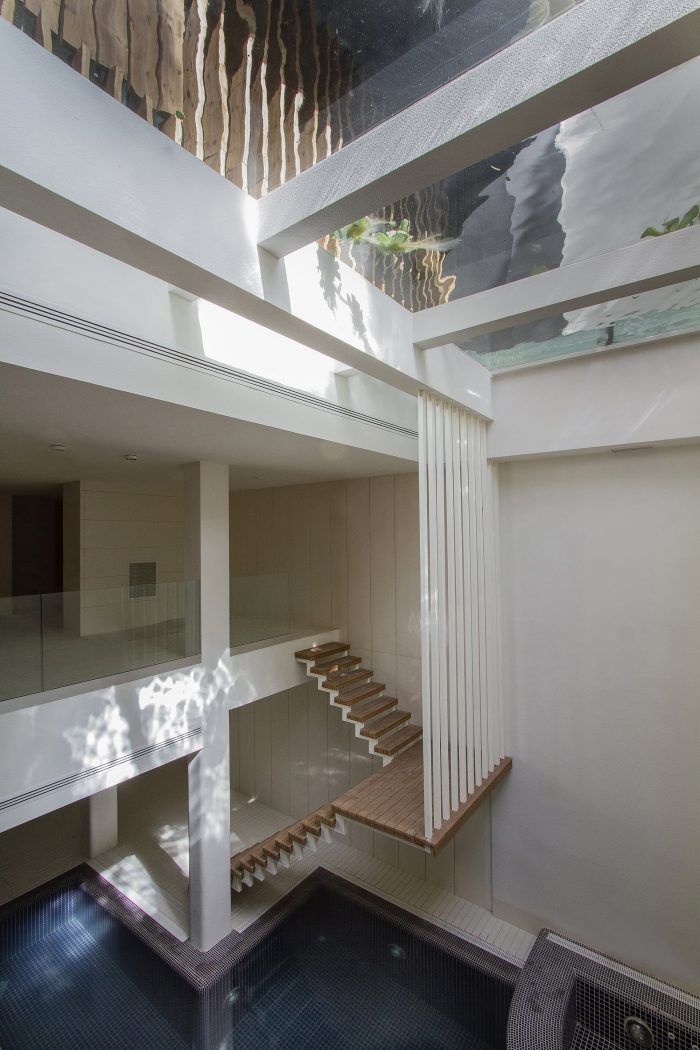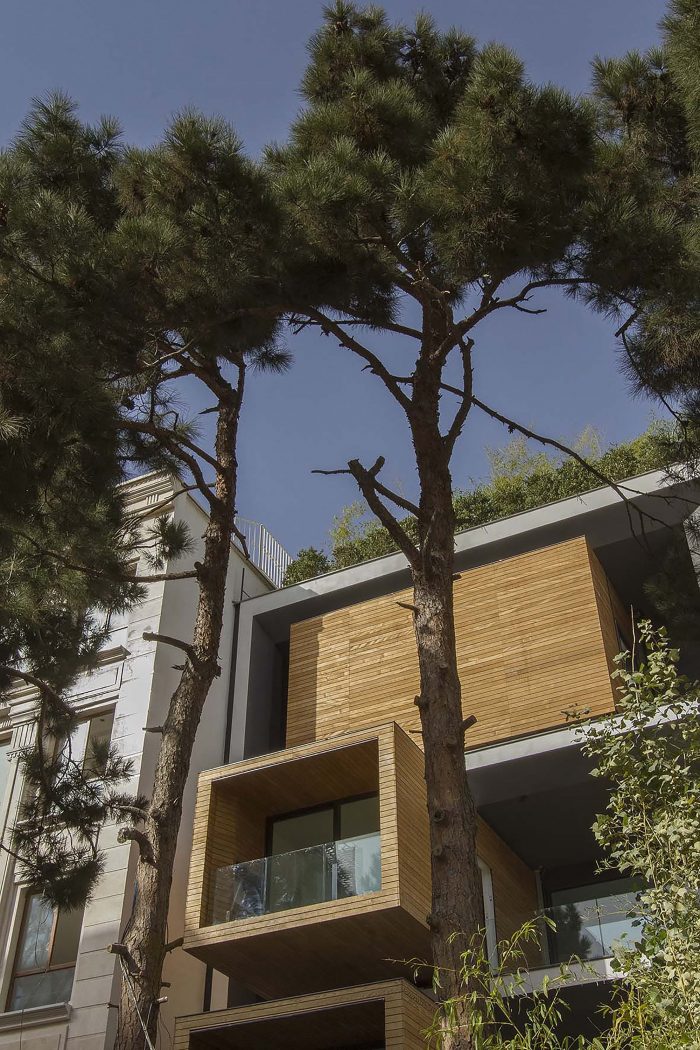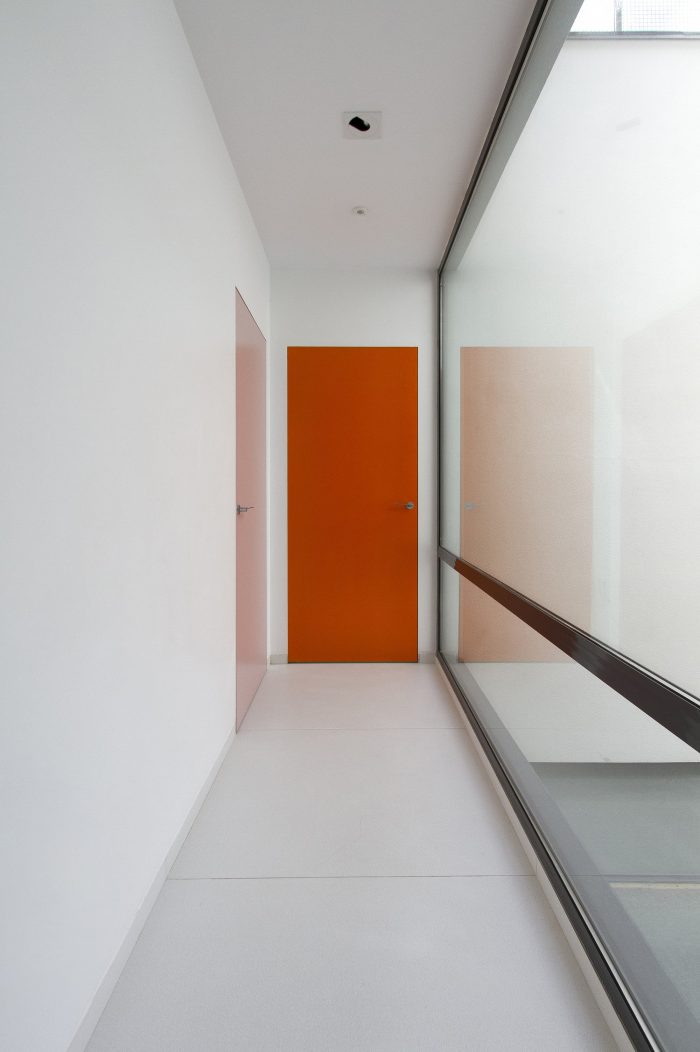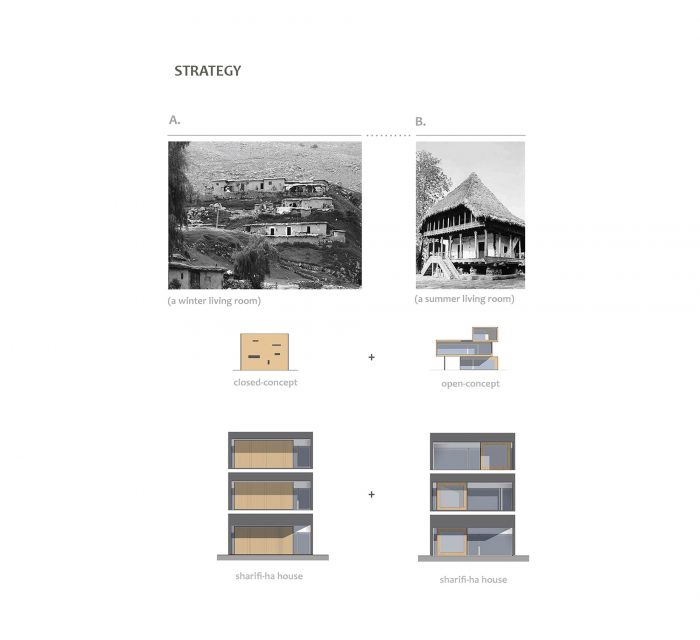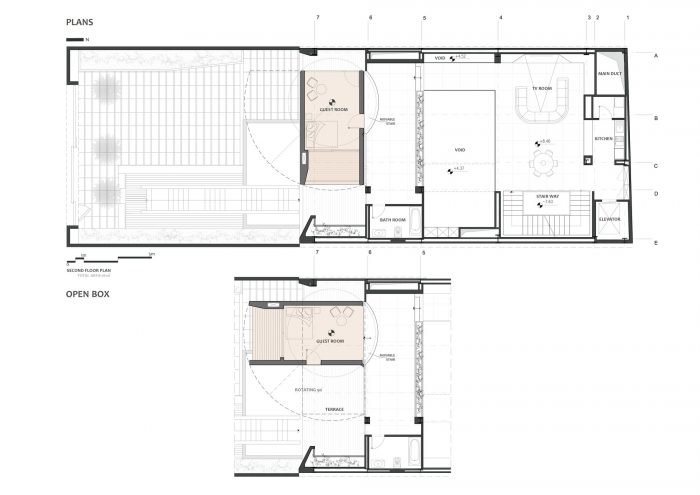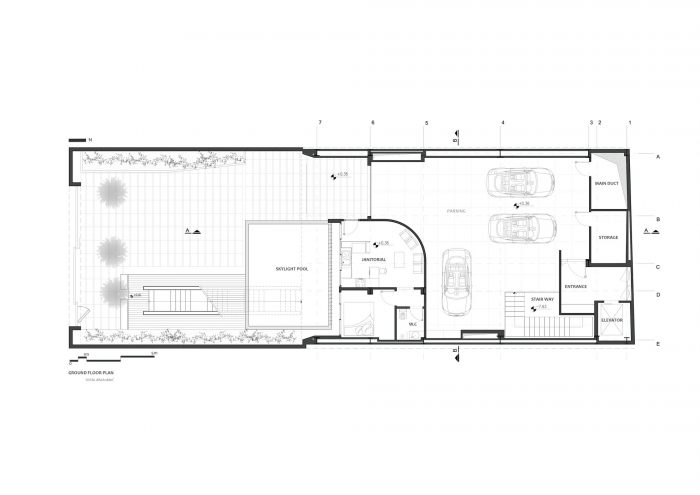不确定性和灵活性是Sharifi-ha之家的设计理念的核心。室内的感觉和空间质量,以及其外部的形式配置,直接反应了转箱的位移,导致建筑体积变得开放或封闭,获得内向或外向的特性。这些变化可能会根据季节的变化或平面图的功能方案而发生。
Uncertainty and flexibility lie at the heart of the design concept in Sharifi-ha House. The sensational, spatial qualities of the interiors, as well as the formal configuration of its exterior, directly respond to the displacement of turning boxes that lead the building volume to become open or closed, obtaining introverted or extroverted character. These changes may occur according to changing seasons or functional scenarios of floor plans.
像许多其他城市地块一样,这个项目的土地与它的长度相比,有一个明显狭窄的立面宽度。因此,我们在将二维立面转变为三维立面方面的专业知识变得不可或缺。
Like many other urban plots, the land for this project had a noticeably narrow façade-width compared with its length. Consequently, our expertise in transforming a two-dimensional façade to a three-dimensional one became indispensable.
在这里,建筑体量的开放性/封闭性是对伊朗传统房屋的参考,这些房屋通过为居民提供Zemestan-Neshin(冬季客厅)和Taabestan-Neshin(夏季客厅),动态地作为季节性居住模式。在夏季,Sharifi-ha House提供了一个开放/透明/穿孔的体量,有宽大的露台。
Here, the openness /closure of the building volume is a reference to traditional Iranian houses, which would dynamically serve as seasonal modes of habitation by offering both a Zemestan-Neshin (winter living room) and Taabestan-Neshin (summer living room) to their residents. In summertime, Sharifi-ha House offers an open /transparent /perforated volume with wide, large terraces.
相比之下,在德黑兰寒冷多雪的冬天,这个体量就会自动关闭,提供最小的开口,完全没有那些宽阔的夏季露台。在这个项目中,对开放/封闭类型概念的挑战(内向/外向的特征)导致了一个不断变化的住宅建筑的令人兴奋的空间转变。
In contrast, during Tehran’s cold, snowy winters the volume closes itself, offering minimal openings in total absence of those wide summer terraces. In this project, the challenges to the concepts of open/closed typology (introverted/extroverted character) led to an exciting spatial transformation of an ever-changing residential building.
房子分布在七个楼层:地下两层被分配给家庭聚会、健身设施和健康区,而底层则是停车场和管家室。 公共活动都发生在一楼和二楼,而家庭的私人生活则发生在三楼和四楼。
The House is distributed over seven floors: the two basement floors are allocated to family conviviality, fitness facilities, and wellness areas, while the ground floor hosts parking and housekeeping rooms. Public activities all happen on the first and second floors, and the family’s private life takes place on the third and fourth floors.
该项目由四个主要部分组成;结构的固定体积、空隙,以及固定体积和移动体积分别。当转动箱关闭时,建筑在整个中央空隙的空间中捕捉阳光,它也通过吊桥将两个固定体量连接起来。
The project consisted of four major parts; the fixed volume of the structure, the void, and the fixed volume and the mobile volume, respectively. When the turning boxes are closed, the building captures sunlight throughout the space of the central void, which also connects the two fixed volumes by suspended bridges.
这座房子可以适应居民的功能需求。例如,根据是否有客人,客房(位于二楼)可以重新配置为不同的用途。
The house adapts to the functional needs of its residents. For instance, depending on whether there is a guest or not, the guest room (located on the second floor) can be reconfigured for different purposes.
同样,家庭办公室和早餐室(位于一楼和三楼的翻转房间)也可以根据住户的愿望改变其外观形式。换句话说,总是有可能出现不同的季节性或照明方案,其中一些已经在项目的BMS程序中被考虑。
Similarly, home office and breakfast room (turning rooms on the first and third floors) can change the formality of their appearance according to their residents’ desire. In other words, there is always the possibility of having different seasonal or lighting scenarios, some of which have been already considered in the BMS program of the project.
从最初的设计步骤中,我们注意到外面的三棵松树可以被纳入室内的空间中。现在,在房子的开放模式中,这些树被窗框愉快地捕获。
From the initial design steps, we noticed that three pine trees outside could be incorporated into the spaces of the interior. Now, in the open mode of the house, the trees are pleasantly captured by the window frames.
从允许的建筑边界线后退大约三米,使我们能够通过插入一个玻璃喷泉为地下室楼层提供灿烂的日光。健身区和健康区被安置在喷泉和地下室的游泳池之间,反射装置使水的光芒在整个空间内回荡。
Stepping back for about three meters from the permitted construction boundary line allowed us to provide splendid daylight for the basement floors by inserting a glass fountain. The fitness and wellness areas are accommodated between this fountain and the basement pool where reflective installations reverberate the water’s radiance all over the space.
转动机制的应用制造技术实际上是一个简单的方法;与目前在伊朗用于转动戏剧场景、转动汽车展览、钢铁公司和航运业的地板的方法相同。
The applied manufacturing technique for the turning mechanism was in fact a simple one; the same method which is currently employed in turning theatrical scenes, turning the floor of car exhibitions, steel companies and the shipping industry in Iran.
但是,由于我们的客户本身就喜欢进口CNC和其他类似的德国工业机器,他更希望结构系统在德国制造。这样一来,他可以让他的员工参与制造过程,从而为将来的维护工作培训他们。
But as our client himself was into importing CNC and other similar industrial German machines, he preferred the structural system to be fabricated in Germany. In doing so, he could engage his employees in the manufacturing process and thus train them for future maintenance purposes.
扶手的细节和空气渗透的控制方法是开发车箱设计时考虑的主要问题。设计可折叠的扶手和改进箱子的边缘恰好是我们可行的解决方案。
Details of the handrails and air-penetration controlling methods were major issues considered in developing the design of the turning boxes. Designing foldable handrails and refining the edges of the boxes happened to be our feasible solutions.
考虑到这种建筑的特殊性,结构系统不可避免地是一个定制的系统。在对结构进行数字建模后,我们进行了一系列的SAP2000分析,以检查拟议系统的静态/动态性能。部分可移动是这个结构组件的主要特征,德国制造商公司在整个制造过程中都考虑到了这一点。主要的负载都在起居室的梁上。
Considering the specialties of this kind of architecture, the structural system was inevitably a customized one. After digitally modeling the structure, a series of SAP2000 analysis were undertaken to examine static/dynamic performance of the proposed system. Being partially moveable is the dominant feature of this structural assembly, which was contemplated throughout the fabrication process by the German manufacturer company. The main loads all rest on the beams of the living rooms.
由于转向箱可能采取的各种配置,载荷计算是根据应用于系统的最大可能的载荷值来估计的。此外,为了防止结构变形,在结构的设计/计算过程中考虑到了控制转向箱中可能的振动。
该房屋被命名为Sharifi-ha房屋,以纪念伊朗的传统豪宅。
Due to the various configurations the turning boxes may take, the loading calculation has been estimated based on the largest possible loading value applied to the system. Additionally, in order to prevent structural deformation controlling the probable vibrations in the turning boxes was taken into account during the design/calculations of the structure.
The house was titled Sharifi-ha House, in honor of traditional Iranian mansions.
Architects: NextOffice–Alireza Taghaboni
Area : 1400 m²
Year : 2014
Photographs :Parham Taghioff, Mandana Mansouri, Salar Motahari, Majid Jahangiri
Manufacturers : IB RUBINETTERIE
Mechanical Consultant : Payabanaafarin Company, Mojtaba Arabpour
Electrical Consultant : Payabanaafarin Company, Saeed Afshar
Landscape Consultant : Babak Mostofi Sadri, Omid Abbas Fardi
Construction : Imen Sazeh Fadak Co.
Designer : Alireza Taghaboni
Design Associates : Roohollah Rasouli, Farideh Aghamohammadi
Detailing Design Associates : Bahoor Office (Hamid mohammadi, Amir Taleshi)
Senior Consultant In Detail : Shahnaz Goharbakhsh
Supervisions : Shahnaz Goharbakhsh, Alireza Taghaboni
Project Associates : Mojtaba Moradi, Negar Rahnamazadeh, Asal Karami, Majid Jahangiri, Masoud Saghi, Hossein Naghavi, Fatemeh S.Tabatabaeian, Iman Jalilvand
Structural Consultant : Bastanpol company, Vahid Qarakhniniya
Revolving Rooms System : Bumat Company
Client : Shiraz Municipality
Team : Alireza Taghaboni, Mohamad Motamedinia, Ebrahim Roostaee, Sepideh Sarrafzadeh, Maziar Ghaseminia, Majid Jahangiri, Hoodad Zoroufchiyan, Peyman Nozari, Roza bemani, Arian Spiridonoff, Vahid karamad, Fatemeh Tabatabaeian, Shima Mohammadi, Siavash Shareghi, Homa Asadi, Farideh AghaMohammadi, Mohammad Kahidi, Mehrdad Raoofi, Sahar Mehdizadeh, Gorgin Sharifi, Ali Maleki Kahaki, Sajad hosseini, Tina Shahnazari, Mehdi Pourbasat, Asal Karami, Amin Zargar, Sarvenaz Rezae
City : Tehran
Country : Iran



